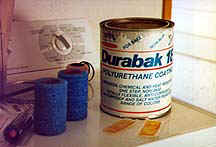 My
4x4 was brand spanking new off the assembly line May 17th,
1998. By June 6th my grey carpeting was unable to be fully
cleaned. I had taken the TJ on a three-day trip in the Sierra Nevada
mountains and gotten it filthy inside and out. Upon returning I removed
all the carpeting and did my best to make it spotless again (hey ? it
was two weeks old!). Even throwing it in the washing machine did no
good. My
4x4 was brand spanking new off the assembly line May 17th,
1998. By June 6th my grey carpeting was unable to be fully
cleaned. I had taken the TJ on a three-day trip in the Sierra Nevada
mountains and gotten it filthy inside and out. Upon returning I removed
all the carpeting and did my best to make it spotless again (hey ? it
was two weeks old!). Even throwing it in the washing machine did no
good.
I began to look for alternatives through
magazines, mailing lists, and internet sites. One obvious choice was to
remove the carpet each time I took a trip off-road. Not a terrible
choice, but kind of a pain in the neck. It doesn?t take long to remove
the carpet, but I already have a few hours of preparation for many trips
I take. And what of spontaneous "I wonder what?s down here"
trips? Carpet removal really didn?t cut it for me.
I thought floor liners might do the
trick. The plastic, removable "bowls" that reside under the
driver?s and passenger?s feet seemed to be a good choice. Matching
color, durability?lots of bonuses. Soon enough, however, I found
information that the liners didn?t fit well, puddled the water and
mud, and just didn?t make the grade.
Decisions, Decisions?
As my Jeep grew up (literally) my
attitude changed from keeping it really nice to keeping it comfortable
but functional. I decided a spray or brush-on tubliner was the way to
solve my problem. I compiled a list of liners on the market. Here is
what I found:
- Professional spray-on liners were only
applicable by their dealers. This ran about $600 to coat the entire
interior of the Jeep. While the resulting liner was very even and
attractive, the cost was better spent on a winch or tires.
- Some do-it-yourself liners only came
in glossy or smooth finishes. I, personally, like a satin or flat
finish on most Jeep accessories. I also wanted a liner with a rough
but pliable texture to grip items I was carrying. The texture would
also keep wet shoes from slipping on the floorboard.
- Some do-it-yourself liners also
required mixing two or three ingredients perfectly to make the liner
before applying. Truthfully, I wanted to make this as easy as
possible, so I looked for a product that came ready to apply.
 What
I found was Durabak, distributed by Cote-L. This tubliner addressed all
my concerns and more. The liner is chemical, flame, and UV
resistant. It is composed of a polyurethane base with ground up
recycled tires in it to provide a durable texture. I spoke with
Jake Ickowicz from Cote-L, and he shipped out a gallon of Light Grey
Durabak to me. Durabak is available by the gallon or by the quart. A
gallon will coat about 60 square feet nicely. I put two good coats on
the entire interior of the TJ, and used about 2/3 of the can. What
I found was Durabak, distributed by Cote-L. This tubliner addressed all
my concerns and more. The liner is chemical, flame, and UV
resistant. It is composed of a polyurethane base with ground up
recycled tires in it to provide a durable texture. I spoke with
Jake Ickowicz from Cote-L, and he shipped out a gallon of Light Grey
Durabak to me. Durabak is available by the gallon or by the quart. A
gallon will coat about 60 square feet nicely. I put two good coats on
the entire interior of the TJ, and used about 2/3 of the can.
Properties
Durabak is available in twelve colors of
the rainbow. It comes in one can, and is ready to apply without mixing
in other ingredients. Once your vehicle has been prepared, the only
steps necessary to apply the product are:
- Pry the sealing clips and lid off
the can
- Stir the Durabak with a drill
chuck-type paint stirring attachment for a good five minutes to
really get the rubber particles distributed well.
- Start applying the liner!
When the can of Durabak arrives, you will
find it securely packed in foam peanuts along with a lengthy properties
sheet. Take the time to browse this sheet, as it provides a wealth of
safety information, as well as material specifications and application
instructions. The unopened can has a shelf life of up to one year.
Soft, porous foam rollers are also
provided with each order of Durabak. You MUST use these if you want the
liner to have the correct texture upon drying. The rollers are designed
to pick up the rubber particles and dispense them correctly on the
surface you are covering. A standard foam or paint roller will not do
the trick. (The liner can also be sprayed on with a Schutz spray
gun)
You can also order small packets of
accelerator with the Durabak. The accelerator is mixed in before
application at a ratio of one packet per quart. The accelerator can
quicken the curing time significantly.
Durabak has the consistency of regular
old house paint, and might even seem a touch thinner. The liner
lays on very smoothly and the rubber particles are no larger than a
grain of sand. Even on vertical surfaces, the stuff sticks well and
doesn?t run. Two coats of Durabak left me with a surface about 1/16th
of an inch thick.
|